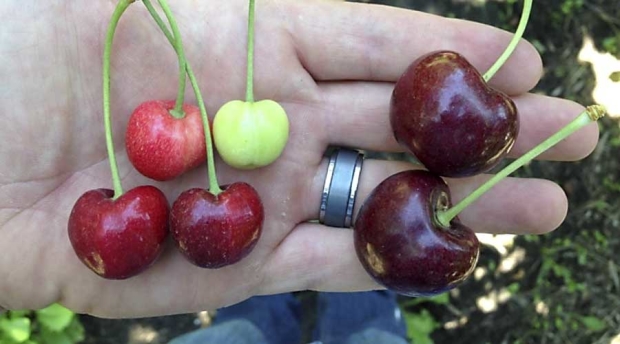
Bing cherries showing symptoms of little cherry disease on left, with healthy cherries on right. (Courtesy Washington State Univeristy)
With three-dozen different viruses that can be found on cherry trees, which ones do growers need to worry about? Cherry viruses were rated on a zero to 10 scale, where zero equals “no need to worry about this virus” and where 10 equals “grower action is imperative!”
The rating is not based on jazzy symptoms that some viruses can produce on a leaf — they may look cool but may not be very important. Instead, this rating system is based on the following questions: Does the virus kill trees? Does the virus significantly lower yields? Does the virus cause unmarketable (bad) fruit? How is the virus spread?

by Jay Pscheidt
Here are some extreme examples of this rating system, using the cherry cultivar Bing as a baseline:
—Cherry Virus A: A newly described latent virus that has no symptoms on Bing and, thus, gets an action rating of zero.
—Plum Pox Virus: This virus is not found in the Pacific Northwest, is described as “the most devastating disease of stone fruit” and is under quarantine from entry into the United States. It does not kill trees but causes poor fruit and is spread rapidly by aphids. This gets an action rating of 10
If we remove all the viruses from the list that do not occur in the PNW and have an action rating of five or lower (since most growers are unlikely to take action for a problem below five), then we are left with the following half-dozen diseases to worry about:
—Little cherry disease: The disease does not kill trees and information on yield reduction was not found. It does result in small fruit that does not ripen and tastes bad. Little cherry virus 2 is spread by the apple mealybug, but Bing has a moderate reaction to this virus (although it is worse on Mazzard rootstock than on Mahaleb). Action rating: 7
—X-Disease: Technically not a virus but it acts like one. It does kill trees, reduces yield and fruit does not ripen. Called little cherry in the ’50s and has very similar symptoms. Spread by leafhoppers. Action rating: 8.
—Cherry mottle leaf: Although leaves have a mottled and wrinkled appearance, this virus does not kill trees. Bing fruits are abnormally small, lack flavor and ripen later than normal. This virus is transmitted by an eriophyid mite. Action rating: 6 to 7.
—Cherry leafroll: Also known as Virus Induced Cherry Decline since it kills trees when co-infected with the ubiquitous pollen-borne viruses Prune dwarf virus and Prunus necrotic ringspot virus. Yields are reduced but there are no fruit symptoms. Aside from root grafts, a vector is notknown. Action rating: 7.
—Necrotic rusty mottle: Trees die in one or two years, yield is reduced along with necrotic spots on leaves. Spread in the orchard is slow by an unknown vector but fast if you propagate from infected trees. Action rating: 7.
—Stem pitting: Not a common problem but will kill trees, reduce yield and cause poor fruit. Spread is by dagger nematodes. Action rating: 7.
Ratings can change depending on cultivar, rootstock, environmental conditions and virus strain. For example, Prunus necrotic ringspot virus gets a low rating of 3 unless you have the Rugose Mosaic strain, in which case the rating goes up to 6. All these ratings are subjective and others might come up with higher or lower ratings but generally, they are in the same range.
Grower actions can range from fumigating new orchards, purchasing virus free planting stock, removal of infected trees or orchards, and vector control. Early detection can help manage these virus and virus-like diseases. If you find small and poorly ripened fruit that tastes bad and/or leaf enations, have the tree tested for virus and take appropriate action once the results come back. •
– Jay W. Pscheidt is a professor and extension plant pathology specialist at Oregon State University. He delivered this information during the Mid-Columbia Cherry Day in February in The Dalles, Oregon. His references for the work included: Hadidi, A., Barba, M., Candresse, T. and Jelkmann, W. 2011. Virus and Virus-like Diseases of Pome and Stone Fruits. St. Paul, MN: APS Press. Lutes, L. and Pscheidt, J. W. 2016. Historical survey of cherry viruses in Oregon. Phytopathology 106:S4.201. Pscheidt, J.W., and Ocamb, C.M., senior editors. 2017. Pacific Northwest Plant Disease Management Handbook. Corvallis, OR: Oregon State University.






Leave A Comment